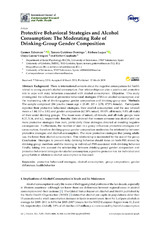Mostrar el registro sencillo del ítem
Protective Behavioral Strategies and Alcohol Consumption: The Moderating Role of Drinking-Group Gender Composition
| dc.contributor.author | Tabernero Urbieta, Carmen | |
| dc.contributor.author | Gutiérrez Domingo, Tamara | |
| dc.contributor.author | Luque Salas, Bárbara | |
| dc.contributor.author | García Vázquez, Olaya | |
| dc.contributor.author | Cuadrado, Esther | |
| dc.date.accessioned | 2019-05-23T11:09:57Z | |
| dc.date.available | 2019-05-23T11:09:57Z | |
| dc.date.issued | 2019 | |
| dc.identifier.uri | http://hdl.handle.net/10396/18618 | |
| dc.description.abstract | There is international concern about the negative consequences for health related to young people’s alcohol consumption. Peer relationships can play a positive and protective role to cope with risky behaviors associated with alcohol consumption. Objective. This study investigated the influence of protective behavioral strategies (PBS) on alcohol consumption and the moderating role of drinking-group gender composition and drinking-group size. Methods. The sample comprised 286 youths (mean age = 23.49; SD = 2.78; 67.5% female). Participants reported their protective behavioral strategies, their alcohol consumption and the size (overall mean = 7.44; SD = 3.83) and gender composition (62.58% mixed; 19.93% all-female; 9.8% all-male) of their social drinking groups. The mean sizes of mixed, all-female, and all-male groups were 8.27, 5.34, and 6.2, respectively. Results. Data showed that women consume less alcohol and use more protective strategies than men, particularly those strategies directed at avoiding negative consequences. Furthermore, the number of men in a group influences protective strategies and consumption, therefore drinking-group gender composition moderates the relationship between protective strategies and alcohol consumption. The more protective strategies that young adults use, the lower their alcohol consumption. This relationship is moderated by the size of the group. Conclusion. Strategies to prevent risky drinking behavior should focus on both PBS shared by drinking-group members and the training in individual PBS associated with drinking behavior. Finally, taking into account the relationship between drinking-group gender composition and protective behavioral strategies for alcohol consumption, a positive protector role for individual and group habits in relation to alcohol consumption is discussed. | es_ES |
| dc.format.mimetype | application/pdf | es_ES |
| dc.language.iso | eng | es_ES |
| dc.publisher | MDPI | es_ES |
| dc.rights | https://creativecommons.org/licenses/by/4.0/ | es_ES |
| dc.source | International Journal of Environmental Research and Public Health 16(5), 900 (2019) | es_ES |
| dc.subject | Protective behavioral strategies | es_ES |
| dc.subject | Alcohol consumption | es_ES |
| dc.subject | Group composition | es_ES |
| dc.subject | Gender differences | es_ES |
| dc.subject | Health behavior | es_ES |
| dc.title | Protective Behavioral Strategies and Alcohol Consumption: The Moderating Role of Drinking-Group Gender Composition | es_ES |
| dc.type | info:eu-repo/semantics/article | es_ES |
| dc.relation.publisherversion | http://dx.doi.org/10.3390/ijerph16050900 | es_ES |
| dc.relation.projectID | Gobierno de España. PSI 2014-58609-R | es_ES |
| dc.rights.accessRights | info:eu-repo/semantics/openAccess | es_ES |

